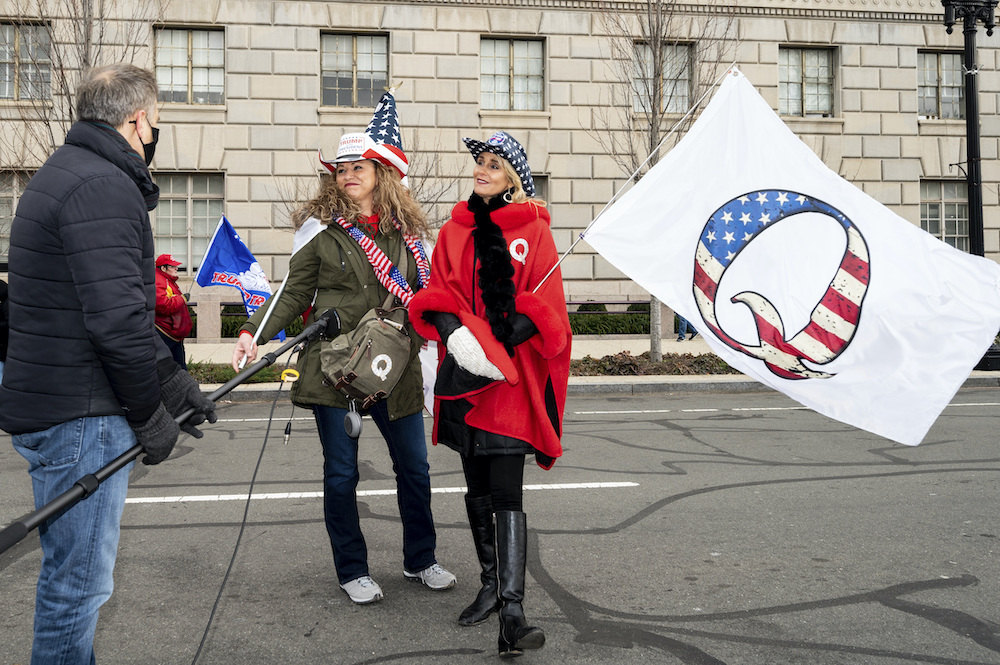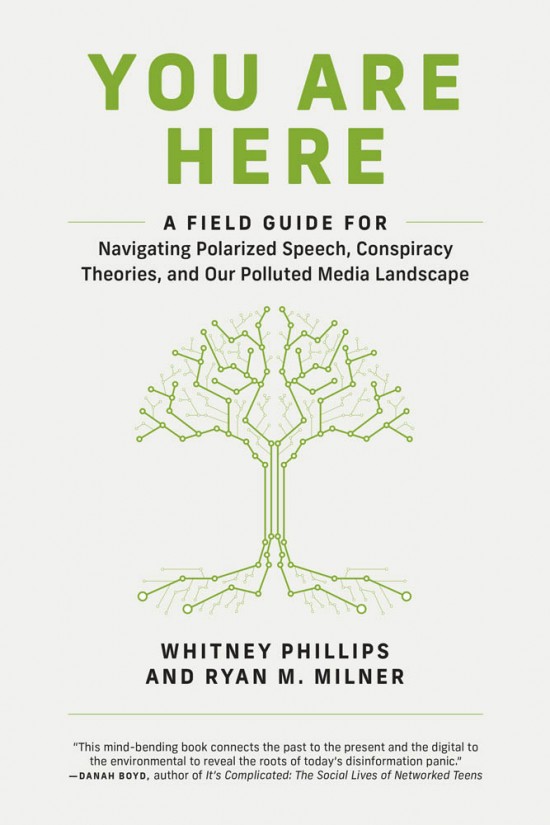
Two women with QAnon attire and flag speaking to a reporter at the pro-Trump rally in Washington, D.C., on January 6

"You Are Here: A Field Guide for Navigating Polarized Speech, Conspiracy Theories, and Our Polluted Media Landscape" by Whitney Phillips and Ryan M. Milner
In “You Are Here: A Field Guide for Navigating Polarized Speech, Conspiracy Theories, and Our Polluted Media Landscape,” Whitney Phillips and Ryan M. Milner assess our media environment — and the crisis that it’s in — and offer strategies, using ecological metaphors, for cleaning up the landscape. In this excerpt, from a section titled “Portrait of a Changing Ecosystem,” the authors examine how the media network crisis drives conspiracy theories.
Three points of divergence between contemporary conspiracy theories and theories of generations past highlight how and why our networks have been pushed into crisis.
First, while conspiracy theories have spread through all kinds of everyday networks since the 1960s—from Kennedy assassination truthers trading self-published speculations to the paranoid separatists that Oklahoma City bomber Timothy McVeigh hobnobbed with at gun shows—conspiratorial frames can now cascade into the feeds of millions of nonbelievers in a matter of seconds. As a result, being a believer in a particular theory is no longer the primary precondition for learning more about it—or for helping propagate it. Deep State theories provide a striking case in point, but they’re hardly anomalous. People can encounter all kinds of theories without even trying, and can send someone else scurrying down the rabbit hole to find more information with a single retweet. Even if they’re sharing with an eye roll, because the story is just too bizarre.
Second, although the United States has incubated a robust, increasingly polarized right-wing media apparatus since the 1950s, this apparatus has been turbocharged by network climate change. One of the contributing factors is what computer scientist Kate Starbird and her team call an “echo-system.” When people ensconced within their echo-system see information, they have good reason to trust that it is correct; it has been corroborated here and there and everywhere they look. This corroboration, however, is an illusion of source diversity, not actual source diversity. As Anna Merlan argues, right-wing media, encompassing everything from 8chan to reactionary YouTube channels to Fox News to fundamentalist radio to Donald Trump and back again, is nothing if not an echo-system. The Left, of course, has its own ideological silos—but not with the same insularity, and not emerging from decades of ideological intensification. Ironically, the powerful signal boosting afforded by the center-left is a major catalyst for far-right intensification. Recall, for instance, how little attention mainstream journalists paid to the extraordinary popularity of televangelists in the 1970s and 1980s. Tens of millions of Americans’ lives were shaped by televangelism. For mainstream journalists, though, fundamentalist stalwarts like Pat Robertson and Jerry Falwell were a passing joke, if they had heard the names at all. Over time, slowly and steadily, network climate change rendered the barriers between the Left and the Right increasingly permeable. The Left is now well aware of far-right goings-on.
What they do isn’t just newsworthy. It’s clickbait.
The most immediate consequence is that far-right messages—conspiracy theories very much included—that never would have traveled beyond reactionary circles are catapulted across the ecosystem. This creates new audiences for reactionary claims. Some are taken in. Others have their perspectives muddied by how incompatible far-right claims are with center-left accounts of the same events—to the delight of media manipulators, who succeed when people take in all the noise, throw up their hands because “nobody really knows the truth,” and stop paying attention entirely.
A less obvious but just as consequential effect of center-left signal boosting is to trigger a full-on Galapagos response. People further to the left, who have long been separated from those further to the right, are for the first time seeing what to them feels like a whole new species. And they don’t like it—because what in the hell kind of alternative-fact bullshit are they talking about? People on the far right have long harbored, and indeed have long publicized, similar antipathies—unbeknownst to the liberals they’ve been railing against for decades. Back then, the Right was fighting a holy war only they knew was happening. Now, center-left media comment on the far right’s every maneuver, mocking them, approaching them like malformed birds—only reinforcing right-wing beliefs about the elitist, biased, fake-news mainstream.
This disconnect is devastating for democracy. It’s bad enough that folks on the Left and Right see each other as actual monsters; that makes consensus-building, not to mention policymaking, next to impossible. It’s worse that one side has evolved to mistrust facts, science, and institutional knowledge, including the boring but crucial role establishment bureaucracy plays in keeping the world running; the COVID-19 pandemic illustrates the sweeping public health consequences of the impulse to trust no leftie, a designation equated with anyone who can claim expertise based on training and experience. The disconnect between the Left and Right has also ratcheted up the heat in an already-warming informational climate, ensuring that the most outrageous reactionary claims can spool up into raging storms very quickly with very little coordinated effort.
These informational consequences speak to the final historical divergence between conspiracy theories past and present. Ever since the 1960s, when trust in government began to plummet and antigovernment conspiracy theories became something of a national pastime, everyday citizens have clamored to “get to the bottom of things.” The same impulse has, for just as long, inspired conspiracy entrepreneurs to cash in on America’s increasingly paranoid style. Social media certainly didn’t create either impulse, but they have changed the alchemy of both. Everyday people—and, increasingly, politicians—looking to “get to the bottom of things” have more access to more information, more opportunities to mine more networks, and more incentive to parlay those investigations into a personal brand. Donald Trump is a classic example. He launched his political career in 2011 by propagating the racist Birther conspiracy theory, which maintains that President Barack Obama wasn’t really born in the United States. In speech after speech and interview after interview, Trump wouldn’t let questions about Obama’s birth certificate go. As they would continue doing for years about lie after lie, reality TV spectacle after reality TV spectacle, the center-left news media rewarded him for his efforts.
As Trump’s political genesis demonstrates, citizen sleuthing and conspiracy entrepreneurship have fundamentally fused. More than that, conspiracy theories have become for many a full-time job. And not just any job; the kind of job that can get you invited to the White House. On July 11, 2019, for example, Trump hosted a who’s who of far-right conspiracy entrepreneurs at a “social media summit.” During the event, Trump praised attendees for their ability to spread reactionary pollution. “The crap you think of is unbelievable,” Trump fawned. “I mean it’s genius—but it’s bad.”
Peddling conspiracy theories and courting conspiracy theorists have become, in short, good business and good politics. The extent of these financial and political benefits isn’t just supported but often outright encouraged by the contemporary media climate. Enter the new normal of extreme weather events. After all, peddling conspiracies creates visibility, and visibility creates votes, or money, or both. So that’s what politicians, particularly on the Right, do—because they benefit. That’s also what everyday citizens, particularly on the Right, do—because they benefit. In many cases, it’s all just a presidential retweet away.



